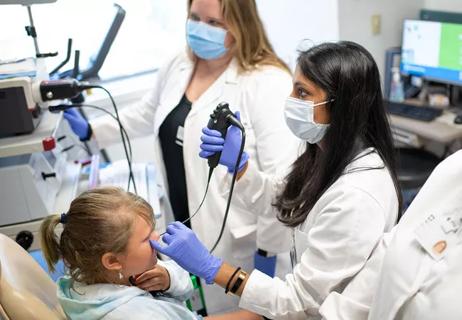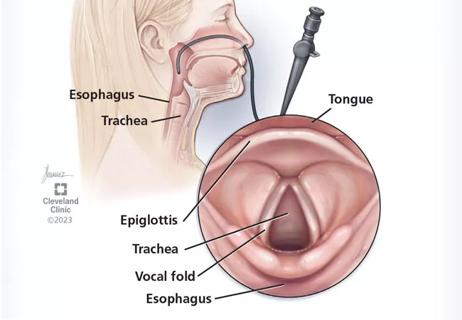A wide-ranging discussion on the latest in laryngology
After attending this year’s Combined Otolaryngology Spring Meetings (COSM) in Chicago, Michael Benninger, MD, sat down with Paul Bryson, MD, MBA to discuss some of his, research, his biggest takeaways from the meeting and what else he’s excited about in the field of laryngology.
Advertisement
Cleveland Clinic is a non-profit academic medical center. Advertising on our site helps support our mission. We do not endorse non-Cleveland Clinic products or services. Policy
“A majority of our [surgeries] are done under THRIVE anesthetic, which is basically high-flow oxygen anesthesia,” says Dr. Benninger. “We presented at COSM about how safe it is — can you use things like lasers, coblation and other things and have a risk of an operating room fire [due to a high-oxygen field]?”
He continues, “Our study used a cadaver model, and we measured oxygenation throughout the field and tried to determine where the oxygen was highly concentrated. Then we used the CO2 laser and a KTP laser. We actually tried to start a fire, and we couldn't start one. If you are using coblation, I think the risks are even lower because it's under saline. So, it's very safe if people are cautious and follow normal operating room protocols in relationship to fire prevention.”
In their recent episode of Cleveland Clinic’s Head and Neck Innovations podcast, Drs. Benninger and Bryson go over a wide range of laryngology topics. In addition to the safety of THRIVE, they also discuss:
Click the podcast player above to listen to the episode now, or read on for a short, edited excerpt. Check out more Head and Neck Innovations episodes at clevelandclinic.org/podcasts/head-and-neck-innovations or wherever you get your podcasts.
Podcast host Paul Bryson, MD, MBA: What else stood out to you? You mentioned your interest in chronic cough and hypersensitivity disorders in the larynx. Anything on those topics that you want to highlight?
Advertisement
Michael Benninger, MD: Well, the interesting thing is we thought for a long time there would be these new P2X3 inhibitor drugs that would come out and would give us an option in patients with chronic hypersensitivity disorders such as chronic cough or unexplained chronic cough. They've basically fallen by the wayside as far as we can tell. There's one that I know of that's still in development, but the FDA hasn't approved it, and it hasn't been approved in other countries.
So, we see this complex group of patients who have had everything done for their chronic cough…Well, our next modality tended to be neuromodulator medications such as gabapentin, amitriptyline or nortriptyline. But only a certain number of patients respond to those, so we were kind of stuck with a high percentage of patients who had no relief for their chronic cough.
I saw a patient in the office about a year ago who was coughing every 15 seconds, and apparently throughout the night. Over the past five years, we've been doing superior laryngeal nerve blocks, Blake Simpson initially introduced this, and it was fantastic. We adopted it fairly quickly, and now, we've done hundreds of injections in our group for people with chronic cough [and seen] remarkably good success with about 75 to 80% of people having some response, about 50% of people having a 90%+ response.
…Well, we started to think, maybe there's a lot of hypersensitivity involved, and cough is just one manifestation. For patients with chronic throat pain, patients with a lump in their throat or globus sensation, chronic throat clearing or just generalized throat discomfort, this [could be] part of a bigger vagal sensory neuropathy that is all tied up together. We found in those groups, maybe not quite as well as the chronic cough patients, we've had a pretty remarkable response with a number of those orders, probably about 50% of those patients.
Advertisement
Dr. Bryson: [Hypersensitivity disorders in the larynx] is another one of those instances where the paradigms in the approach have changed a bit over the last 10 years or so. There was a point where a lot of complaints were attributed to laryngopharyngeal reflux or things like that, and it's been nice to be able to have an arsenal of things to try for people and spare people oral medications if you can.
Dr. Benninger: We published a paper with Andrea Campagnolo, a Brazilian otolaryngologist who treats the stars in Rio de Janeiro, in 2016 discussing this whole idea: Is this all part of a big vagal neuropathy? If it is, then maybe reflux is related to it. Also, decreased esophageal motility, decreased lower esophageal sphincter tone, decreased gastric emptying. The gallbladder is not necessarily releasing the bile acids that it's needed to or at the wrong time, so it's kind of exciting. I think the other exciting thing with reflux is increasing use of the alginates and moving away from the proton pump inhibitors. The alginates are very different the way they work.
Dr. Bryson: Yeah, they're almost nutraceutical, right? They're not traditional medicines, and so they help form this little barrier raft in the stomach when you take them. Yeah, that's a great point.
Dr. Benninger: And they're relatively inexpensive and you buy them over the counter. I think there's one limitation that people don't really pay much attention to is that they may not be very effective at bedtime because the lower esophageal sphincter, if you're lying flat, is lower than the acid level in your stomach, so you either have to elevate or you have to turn on the side to try to keep that acid level actually below the lower esophageal sphincter.
Advertisement
Advertisement

By working in tandem, a pediatric otolaryngologist and speech-language pathologist can diagnose conditions and develop treatment plans in the same visit

New innovations in upper airway care and insights into the Pediatric Voice Center

A multidisciplinary approach and individualized plan of care are imperative

Insight on larynx disorders and treatments

3 pediatric gastroenterologists discuss advances in their diagnostic toolkits

Injections and surgical procedures are among the therapies for patients with early and late vocal cord paralysis

Cleveland Clinic physicians weigh in

A recently published case series highlights the broad range of laryngeal findings that can present among individuals with EDS